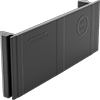Filter by
Thickness
Shape
Color
Performance
Flexibility
Clarity
For Use With
Comparable To
Maximum Temperature
Hardness Rating
DFARS Specialty Metals
Relative Friction Rating
Raw Materials
Communication
Fabricating and Machining
Electrical
Fluid Handling
Material Handling
Facility and Grounds Maintenance
Building and Machinery Hardware
Safety Equipment


















































